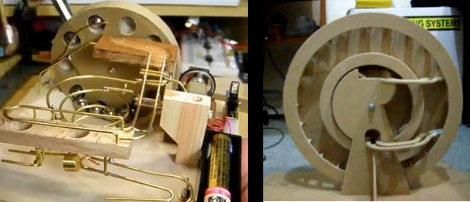
We’re going to let you decide which of these two projects is a delight, and which is amusing.
The project on the left is a desktop kinetic sculpture. We like it because of its size and simplicity. A single AA battery drives the gear head motor that provides the lift for the metal balls. There are several different routes for them to take in returning to the lift wheel, each route determined by a mechanical combination of the metal spheres. This is more of a month-long build than some of the other kinetic devices we’ve seen which could take a lifetime.
The offering on the right is a perpetual motion machine. Well, it will be once that guy gets the kinks worked out. You can see him explain how he intends this works in the video after the break. We’re not betting on perpetual motion, but if we did, our money would be on something like the Steorn Orbo replica and not on this.
















